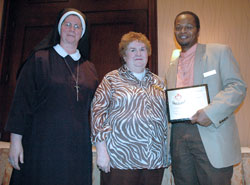Changing hearts is key in pro-life movement, priest says

Servants of the Gospel of Life Sister Diane Carollo, director of the archdiocesan Office for Pro-Life Ministry, and Eileen Hartman, director the Gabriel Project of Indiana, pose with Eric Slaughter. Slaughter, a member of Our Lady of the Most Holy Rosary Parish in Indianapolis, received a Pro Vita Award on March 7 for his pro-life work in the archdiocese. (Photo by Sean Gallagher)
By Sean Gallagher
In order for America to truly become a pro-life country, hearts will need to be changed, first and foremost.
This will happen through prayer and through Catholic married couples fully living out their sacramental relationship and proclaiming its beauty to the world, especially to the younger generation.
That was the message that Father Jonathan Meyer, administrator of St. Joseph and St. Anne parishes, both in Jennings County, passionately shared with more than 450 pro-life supporters who attended the fifth annual Catholic Pro-Life Dinner on March 7 in downtown Indianapolis.
The fundraising dinner was sponsored by the Catholic Life Network, which is made up of the archdiocesan Office for Pro-Life Ministry, the Gabriel Project of Indiana and the archdiocesan-based Abba Father chapter of Catholics United for the Faith.
Catholic Life Network Pro Vita Awards for distinguished volunteer service were presented to Margi Logan, a member of Holy Spirit Parish in Indianapolis and a longtime Birthline volunteer, and Mary Ann Wyand, a member of Our Lady of the Most Holy Rosary Parish in Indianapolis, for 15 years of service on the former archdiocesan Pro-Life Activities Advisory Committee. Wyand was also recognized for her many years of pro-life journalism as a senior reporter for The Criterion.
Also receiving Pro Vita Awards were Marian Copley, a member of Our Lady of Mount Carmel Parish in Carmel, Ind., in the Lafayette Diocese for her work in coordinating the Gabriel Project in her parish and Eric Slaughter, a Holy Rosary parishioner, for his work in promoting Rachel’s Vineyard Retreats and helping to coordinate the “40 Days for Life” campaign in Indianapolis.
Father Meyer recalled how, as a college student in the mid-1990s, he was pro-choice.
He took this position, before he was a seminarian, even though he had known that abortion was wrong since he was a young boy and had seen a bumper sticker that read “Abortion stops a beating heart.”
“That bumper sticker is in the back of my head,” Father Meyer said. “For some reason, that image is in the back of my head. I knew that abortion stopped a beating heart. But it was not here [in his heart].”
He said how, in his more than five years of leading archdiocesan youth ministry efforts, he had used many gimmicks to get teenagers to think about weighty topics such as abortion.
He told his listeners, however, that the important pro-life work of changing hearts can’t happen through gimmicks.
“Only Christ can change a heart,” Father Meyer said.
When hearts are changed, he said, people start consciously living in the presence of God.
Father Meyer argued that the way pro-life supporters can change hearts, and accept the Church’s teachings on life, is to support and live out its teachings on the family, marriage and sexuality in what Pope John Paul II called the “Theology of the Body.”
“If we truly want a pro-life America, we have to truly understand the dignity and beauty of God’s plan for human sexuality,” he said. “Behind almost every single abortion, you’ll find incidents of lust where a man and a woman did not enter into an act of love. And because of that lust, a child is lost.”
Father Meyer explained that the “Theology of the Body” emphasizes how Adam and Eve, before original sin, were in complete harmony with each other and with God, and how that state is presented again at the end of the book of Revelation in its portrayal of the wedding of the Lamb in heaven, where Christ is presented with his spotless bride, the Church.
This mystical theology is concretely applied, he said, in everyday life in Christian marriages where, as St. Paul explained in his Letter to the Ephesians, husbands are symbols of Christ and wives embody the Church.
For husbands, Father Meyer said, the message is clear.
“What is a man called to be before his wife? ‘This is my body, given up for you,’ ” he said. “There is no lust. There is no domination. There is no abuse. It’s a total self-offering.”
Father Meyer then reflected on how women are images of the Church.
“A woman’s body … receives, conceives, brings forth life and nurtures it at her own breast,” he said. “It is the Church. And we know this most specifically because there was a woman at a very young age in Nazareth who received divine life, conceived divine life, brought forth divine life in Bethlehem and then nurtured it at her breast. And we call her the Mother of the Church.”
Father Meyer said living out this vision requires constant prayer.
“If we are not people who are consistently before our God, we cannot know what it is to be a man and a woman,” he said. “We cannot know what it means to be in eternal communion. And we will not bring forth the life that we are called to [bring forth].”
Father Meyer then challenged his listeners to embody the Church’s vision of marriage and share it with young people.
“Do we realize the beauty that we are called to live in the story of salvation?” he asked. “Live your sacrament all the more. Faithfully live it all the more.
“And teach it. … If we tell [young people] how good [sex] is, how beautiful it is, how glorious it is, then, from the very get-go, from the very beginning, we can begin to, hopefully through God’s grace, through our prayers, change marriage and thus change the family and thus change society and thus [change] the world.” †
